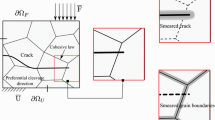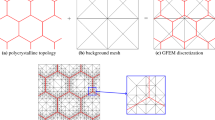Abstract
Failure at grain boundaries has a critical effect on the overall fracture behaviour of polycrystalline aggregates, as is the case in many metals. In the case of dynamic embrittlement, segregation of impurities occurs at grain boundaries, lowering their cohesive strength. The material response is then dominantly determined by grain boundary properties. The self-consistent scheme is extended to account for grain boundary decohesion by using a cohesive law to represent crack initiation and propagation. After introducing the imperfect interface conditions into the Eshelby’s equivalent inclusion solution, the effective tensile response and brittle intergranular fracture of a Cu–Ni–Si alloy is predicted. The proposed analytical model allows for the identification of parameters for both crystal plasticity and cohesive constitutive laws, from a single macroscopic tensile curve. Afterwards, multiscale computations of artificial microstructures are done using the analytically calibrated values of material parameters. Comparison of the results with experimental data shows a satisfactory agreement.















Similar content being viewed by others
References
Achenbach JD, Zhu H (1989) Effect of interfacial zone on mechanical behavior and failure of fiber-reinforced composites. J Mech Phys Solids 37:381–393
Benveniste Y (1985) The effective mechanical behaviour of composite materials with imperfect contact between the constituents. Mech Mater 4:197–208
Berveiller M, Zaoui A (1979) An extension of the self-consistent scheme to plastically flowing polycrystal. J Mech Phys Solids 26:325–344
Cerrone AR, Heber G, Wawrzynek PA, Paulino GH, Ingraffea AR (2011) Modeling microstructurally small fatigue cracking processes in an aluminum alloy with the PPR cohesive zone model. In: Proceedings of EMI 2011, Boston
Cavalcante-Neto JB, Wawrzynek PA, Carvalho TM, Martha LF, Ingraffea AR (2001) An algorithm for three-dimensional mesh generation for arbitrary regions with cracks. Eng Comput 17:75–91
Cavalcante-Neto JB, Martha LF, Wawrzynek PA, Ingraffea AR (2005) A back-tracking procedure for optimization of simplex meshes. Commun Numer Meth En 21(12):711–722
Cuitino AM, Ortiz M (1993) Computational modelling of single crystals. Model Simul Mater Sci 1:225–263
Dugdale S (1960) Yielding of steel sheets containing slits. J Mech Phys Solids 8:100–104
Duvaut G, Lions JL (1972) Les inéquations en mécanique et en physique. Dunod, Paris
Eshelby JD (1957) The determination of the elastic field of an ellipsoidal inclusion and related problems. Proc R Soc Lond A Math 241:376–396
Field DA (1988) Laplacian smoothing and Delaunay triangulations. Commun Appl Numer Methods 4(6):709–712
Groeber M, Ghosh S, Uchic MD, Dimiduk DM (2008a) A framework for automated analysis and simulation of 3D polycrystalline microstructures. Part 1: statistical characterization. Acta Mater 56(6):1257–1273
Groeber M, Ghosh S, Uchic MD, Dimiduk DM (2008b) A framework for automated analysis and simulation of 3D polycrystalline microstructures. Part 2: synthetic structure generation. Acta Mater 56(6):1274–1287
Hashin Z (1991) The spherical inclusion with imperfect interface. J Appl Mech T ASME 58:444–449
Hill R (1965a) A self-consistent mechanics of composite materials. J Mech Phys Solids 13:213–222
Hill R (1965b) Continuum micro-mechanisms of elastoplastic polycrystals. J Mech Phys Solids 13:89–101
Kröner E (1958) Berechnung der elastischen konstanten des vielkristalls aus den konstanten des einskristalls. Zeitschrift fur Physik 151:504–518
Kröner E (1961) Zur plastischen verformung des Vielkristalls. Acta Metall 9:155–161
Lee HK, Pyo SH (2007) Micromechanics-based elastic damage modeling of particulate composites with weakened interfaces. Int J Solids Struct 44:8390–8406
Méric L, Cailletaud G (1991) Single crystal modeling for structural calculations: part 2-finite element implementation. J Eng Mater-T ASME 113:171–182
Misra RDK, Prasad VS, Rao PR (1996) Dynamic embrittlement in an age-hardenable copper-chromium. Scr Mater 35:129–133
Mori T, Tanaka K (1973) Average stress in matrix and average elastic energy of materials with misfitting inclusions. Acta Metall 21:571–574
Mura T (1987) Micromechanics of defects in solids. Kluwer Academic Publishers, Dordrecht
Nathani H, Misra RDK (2004) Characteristics of intermediate temperature dynamic embrittlement of age hardenable copper-chromium alloys. Mater Sci Technol Ser 20:546–549
Othmani Y, Delannay L, Doghri I (2011) Equivalent inclusion solution adapted to particle debonding with a non-linear cohesive law. Int J Solids Struct 48:3326–3335
Priester L (2011) Joints de grains et plasticité cristalline. Hermes, Paris
Qu J (1993a) Eshelby tensor for an elastic inclusion with slightly weakened interface. J Appl Mech-T ASME 60:1048–1050
Qu J (1993b) The effect of slightly weakened interfaces on the overall elastic properties of composite materials. Mech Mater 14:269–281
Rose JH, Ferrante J, Smith JR (1981) Universal binding energy curves for metals and bimetallic interfaces. Phys Rev Lett 47:675–678
Simo JC, Kennedy JG, Govindjee S (1988) Non-smooth multisurface plasticity and viscoplasticity. Loading/unloading conditions and numerical algorithms. Int J Numer Methods Eng 26:2161–2185
Sun Z (2008) Contribution à l’étude des propriétés mécaniques des alliages de cuivre à durcissement structural Cu–Ni–Si et Cu–Cr–Zr : influence de la microstructure et des conditions d’utilisation. PhD Thesis, Lyon
Sun Z, Laitem C, Vincent A (2008) Dynamic embrittlement at intermediate temperature in a Cu–Ni–Si alloy. Mater Sci Eng A 477:145–152
Tan H, Huang Y, Liu C, Geubelle PH (2005) The Mori-Tanaka method for composite materials with nonlinear interface debonding. Int J Plast 21:1890–1918
Tan H, Huang Y, Liu C, Geubellle PH (2006) Effect of nonlinear interface debonding on the constitutive model of composite materials. Int J Multiscale Comput Eng 4:147–167
Tan H, Huang Y, Liu C, Ravichandran G, Paulino GH (2007) Constitutive behaviors of composites with interface debonding: the extended Mori-Tanaka method for uniaxial tension. Int J Fract 146:139–148
Tvergaard V, Hutchinson JW (1992) The relation between crack growth resistance and fracture process parameters in elastic–plastic solids. J Mech Phys Solids 40:1377–1397
Van der Ven A, Ceder G (2003) Impurity-induced van der Waals transition during decohesion. Phys Rev B 67:060101
Wu Z, Sullivan JM (2003) Multiple material marching cubes algorithm. Int J Numer Methods Eng 58(2):189–207
Zhong Z, Yu XB, Meguid SA (2004) 3D micromechanical modeling of particulate composite materials with imperfect interface. Int J Multiscale Comp Eng 2:172–187
Acknowledgments
The authors wish to express their gratitude to Albert Cerrone, of the Cornell Fracture Group in Cornell University, for his valuable advice on the use of DREAM3D and his help for the insertion of cohesive elements in the 3D synthetic microstructures.
Author information
Authors and Affiliations
Corresponding author
Appendices
Appendix 1: Expression of the classical Eshelby tensor \(S_{ijkl} \)
In the case where the matrix (equivalent homogeneous medium) is isotropic, and for a spherical inclusion, the classical Eshelby tensor is given by:
where \(\nu _0 \) denotes the Poisson’s ratio of the equivalent homogeneous medium.
Appendix 2: Expression of the fourth-rank tensor \(\varGamma _{ijkl} \)
Computation of the average over \(\varOmega \) of tensor \(\varGamma _{ijkl}\), as defined in Eq. (21), results from long algebraic developments (Othmani et al. 2011). Accounting for the isotropy of the stiffness tensor and considering a spherical inclusion of radius \(a\), one can find:
where \(E_0 \) and \(\nu _0 \) are the Young’s modulus and the Poisson’s ratio of the equivalent homogeneous medium, and \(\alpha \) and \(\beta \) are the interface compliances in the tangential and normal directions.
Appendix 3: Expression of the fourth-rank tensor \(R_{ijkl} \)
The expression of tensor \(R_{ijkl} \) depends on the interface properties (through the compliances \(\alpha \) and \(\beta )\) and the geometry of the inclusion. In the case of a sphere of radius \(a\), it is can be simplified as (Qu 1993b):
Appendix 4: Computational chart for the self-consistent scheme with imperfect interfaces
- a. \(\bullet \) :
-
Microstructure generation with \(N_g \) grains of random crystallographic orientations
- b. \(\bullet \) :
-
Beginning of a new step with stepsize set to the trial value \({\Delta } t_{n+1} \)
-
Prescribe the macroscopic strain tensor \(\underline{{\varvec{E}}}\left( {t_{n+1} } \right) \) to the polycrystal
-
Estimate the macroscopic stress tensor using the effective secant moduli of the damaged polycrystal (i.e. with degraded interfaces), \(\underline{\varSigma }\left( {t_{n+1} } \right) ={\tilde{\underline{\underline{{\varvec{L}}}}}} ^{eff}:\underline{{\varvec{E}}}\left( {t_{n+1} } \right) \)
-
For each slip system \(s\) of grain \(g\):
-
Evaluate the truncation error according to Eq. (18)
-
Evaluate \({\Delta } t_{opt} \) according to Eq. (19)
-
If \(Err>Tol\) then
-
–
Reduce stepsize \({\Delta } t_{n+1} \!=\!\max \left( \! {\Delta } t_{opt}, 0.1{\Delta } t_{n+1} \right) \)
-
–
Goto b for another try
Else
-
–
Compute stepsize of next step \({\Delta } t_{n+1} =\min \) \(\left( {{\Delta } t_{opt} ,5{\Delta } t_{n+1} } \right) \)
End if
-
–
-
Update the macroscopic stress tensor \(\underline{\varSigma }\) with Eq. (1)
-
Update the macroscopic plastic strain \(\underline{{\varvec{E}}}^{p}\) with Eq. (13)
-
Update the secant moduli of the equivalent medium and the secant compliances of the interfaces
-
Update the elastic stiffness tensor of the damaged polycrystal (i.e. with degraded interfaces) according to Eq. (28)
-
Goto b for next step
Appendix 5: Implementation of viscous regularization
Firstly, it is recalled that, in 3D finite element implementation of cohesive elements, the effective opening displacement \(\delta \) is based on three components because a second tangential displacement is introduced. Consequently, the three components of traction are given according to:
where \(n,t_1 ,t_2 \) denotes the normal and the two shear directions of the cohesive element, respectively (Fig. 16). The normal direction always points out of the plane of the cohesive element. The parameters \(k_0 \) and \(\psi \) are the undamaged normal stiffness and the coupling parameter, respectively. From there, the regularization process requires the use of a viscous damage variable, \(d_v \), which is computed based on the damage variable, \(d\), evaluated in the inviscid case:
where \(\mu \) is the viscosity parameter. The implicit backward Euler algorithm, as proposed by Simo et al. (1988), is used in the present study giving a first order accurate formula for \(d_v \) at time \(t^{\left( {n+1} \right) }\):
The quantities with exponent \(n\) are the converged values at the last time increment \(t^{\left( n \right) }\). Eventually, the computational procedure for viscous regularization is completed by providing the user subroutine with the components of the traction stress vector and the consistent tangent operator at the end of the increment:
where indices \(i,j\) take values \(n,t_1 ,t_2 \). The elastic stiffnesses along the three material directions are linked by \(k_n ={k_{t_1 } }/{\psi ^{2}}={k_{t_2 } }/{\psi ^{2}}=k_0 \).
Rights and permissions
About this article
Cite this article
Benabou, L., Sun, Z. Analytical homogenization modeling and computational simulation of intergranular fracture in polycrystals. Int J Fract 193, 59–75 (2015). https://doi.org/10.1007/s10704-015-0018-1
Received:
Accepted:
Published:
Issue Date:
DOI: https://doi.org/10.1007/s10704-015-0018-1





